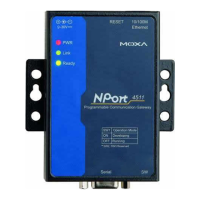RS-485 Termination and Pull High/Low Resistors
In some critical RS-485 environments, you may need to add termination resistors to prevent the
reflection of serial signals. When using termination resistors, it is important to set the pull high/low
resistors correctly so that the electrical signal is not corrupted. For each serial port, DIP switches or
jumper settings are used to set the pull high/low resistor values. For all models except the MB3180,
a built-in 120 Ω termination resistor can also be enabled.
To modify the termination and pull high/low resistor settings, please refer to the hardware reference
chapter for your model.
Do not use the 1 KΩ pull high/low setting on the MGate MB3000 when using the RS-232 interface.
Doing so will degrade the RS-232 signals and reduce the effective communication distance.
Connecting to a Host or the Network
A 10/100BaseT Ethernet port is located on the unit’s front panel. This port is used for the unit’s
connection to a host or Ethernet network, as follows:
For normal operation, use a standard straight-through Ethernet cable to connect the unit to
your Modbus TCP network.
For initial configuration or for troubleshooting purposes, you may connect the unit directly to
a PC. In this case, use a crossover Ethernet cable to connect the unit to your PC’s Ethernet
connector.
The unit’s Link LED will light up to indicate a live Ethernet connection.
For advanced models (MB 3170, MB3170I, MB3270, and MB3270I), two Ethernet ports are
provided. One port can be used to connect to the network, and the other port can be used to connect
to another Ethernet device.
Installing the Software
The Windows management utility is installed from the Document and Software CD. Follow the
onscreen instructions after inserting the CD. For additional details, please refer to Chapter 9.
Mounting the Unit
The unit can be placed on a desktop, mounted on the wall, or mounted on a DIN-rail. The MB3180,
MB3280, and MB3480 require optional attachments for DIN-rail mounting. For additional details,
please refer to the hardware reference chapter for your model.

